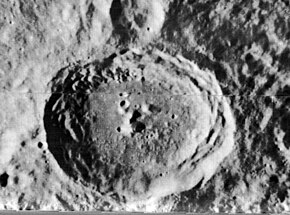This article includes a
list of references,
related reading, or
external links, but its sources remain unclear because it lacks
inline citations. (November 2019) |

Lunar Orbiter 2 image | |
| Coordinates | 30°12′S 173°54′W / 30.2°S 173.9°W |
|---|---|
| Diameter | 82 km |
| Depth | Unknown |
| Colongitude | 187° at sunrise |
| Eponym | O. Kristian Birkeland |
Birkeland is a lunar impact crater that lies in the southern hemisphere on the far side of the Moon. This crater is attached to the central waist of the oddly shaped Van de Graaff crater formation, and may partly account for that crater's figure-8 shape. To the southeast is the large walled plain Leibnitz.
This crater has not been significantly eroded, and the outer rim is well-defined with a well- terraced inner walls around much of the interior. The rim has a slight inward bulge along the north where it is attached to the Van de Graaff formation. The interior floor is relatively level, except in the southeast where there is some rough terrain. There is a central peak formation at the midpoint.
By convention these features are identified on lunar maps by placing the letter on the side of the crater midpoint that is closest to Birkeland.
| Birkeland | Latitude | Longitude | Diameter |
|---|---|---|---|
| M | 32.0° S | 174.1° E | 23 km |
- Andersson, L. E.; Whitaker, E. A. (1982). NASA Catalogue of Lunar Nomenclature. NASA RP-1097.
- Blue, Jennifer (July 25, 2007). "Gazetteer of Planetary Nomenclature". USGS. Retrieved 2007-08-05.
- Bussey, B.; Spudis, P. (2004). The Clementine Atlas of the Moon. New York: Cambridge University Press. ISBN 978-0-521-81528-4.
- Cocks, Elijah E.; Cocks, Josiah C. (1995). Who's Who on the Moon: A Biographical Dictionary of Lunar Nomenclature. Tudor Publishers. ISBN 978-0-936389-27-1.
- McDowell, Jonathan (July 15, 2007). "Lunar Nomenclature". Jonathan's Space Report. Retrieved 2007-10-24.
- Menzel, D. H.; Minnaert, M.; Levin, B.; Dollfus, A.; Bell, B. (1971). "Report on Lunar Nomenclature by the Working Group of Commission 17 of the IAU". Space Science Reviews. 12 (2): 136–186. Bibcode: 1971SSRv...12..136M. doi: 10.1007/BF00171763. S2CID 122125855.
- Moore, Patrick (2001). On the Moon. Sterling Publishing Co. ISBN 978-0-304-35469-6.
- Price, Fred W. (1988). The Moon Observer's Handbook. Cambridge University Press. ISBN 978-0-521-33500-3.
- Rükl, Antonín (1990). Atlas of the Moon. Kalmbach Books. ISBN 978-0-913135-17-4.
- Webb, Rev. T. W. (1962). Celestial Objects for Common Telescopes (6th revised ed.). Dover. ISBN 978-0-486-20917-3.
- Whitaker, Ewen A. (1999). Mapping and Naming the Moon. Cambridge University Press. ISBN 978-0-521-62248-6.
- Wlasuk, Peter T. (2000). Observing the Moon. Springer. ISBN 978-1-85233-193-1.
This article includes a
list of references,
related reading, or
external links, but its sources remain unclear because it lacks
inline citations. (November 2019) |

Lunar Orbiter 2 image | |
| Coordinates | 30°12′S 173°54′W / 30.2°S 173.9°W |
|---|---|
| Diameter | 82 km |
| Depth | Unknown |
| Colongitude | 187° at sunrise |
| Eponym | O. Kristian Birkeland |
Birkeland is a lunar impact crater that lies in the southern hemisphere on the far side of the Moon. This crater is attached to the central waist of the oddly shaped Van de Graaff crater formation, and may partly account for that crater's figure-8 shape. To the southeast is the large walled plain Leibnitz.
This crater has not been significantly eroded, and the outer rim is well-defined with a well- terraced inner walls around much of the interior. The rim has a slight inward bulge along the north where it is attached to the Van de Graaff formation. The interior floor is relatively level, except in the southeast where there is some rough terrain. There is a central peak formation at the midpoint.
By convention these features are identified on lunar maps by placing the letter on the side of the crater midpoint that is closest to Birkeland.
| Birkeland | Latitude | Longitude | Diameter |
|---|---|---|---|
| M | 32.0° S | 174.1° E | 23 km |
- Andersson, L. E.; Whitaker, E. A. (1982). NASA Catalogue of Lunar Nomenclature. NASA RP-1097.
- Blue, Jennifer (July 25, 2007). "Gazetteer of Planetary Nomenclature". USGS. Retrieved 2007-08-05.
- Bussey, B.; Spudis, P. (2004). The Clementine Atlas of the Moon. New York: Cambridge University Press. ISBN 978-0-521-81528-4.
- Cocks, Elijah E.; Cocks, Josiah C. (1995). Who's Who on the Moon: A Biographical Dictionary of Lunar Nomenclature. Tudor Publishers. ISBN 978-0-936389-27-1.
- McDowell, Jonathan (July 15, 2007). "Lunar Nomenclature". Jonathan's Space Report. Retrieved 2007-10-24.
- Menzel, D. H.; Minnaert, M.; Levin, B.; Dollfus, A.; Bell, B. (1971). "Report on Lunar Nomenclature by the Working Group of Commission 17 of the IAU". Space Science Reviews. 12 (2): 136–186. Bibcode: 1971SSRv...12..136M. doi: 10.1007/BF00171763. S2CID 122125855.
- Moore, Patrick (2001). On the Moon. Sterling Publishing Co. ISBN 978-0-304-35469-6.
- Price, Fred W. (1988). The Moon Observer's Handbook. Cambridge University Press. ISBN 978-0-521-33500-3.
- Rükl, Antonín (1990). Atlas of the Moon. Kalmbach Books. ISBN 978-0-913135-17-4.
- Webb, Rev. T. W. (1962). Celestial Objects for Common Telescopes (6th revised ed.). Dover. ISBN 978-0-486-20917-3.
- Whitaker, Ewen A. (1999). Mapping and Naming the Moon. Cambridge University Press. ISBN 978-0-521-62248-6.
- Wlasuk, Peter T. (2000). Observing the Moon. Springer. ISBN 978-1-85233-193-1.
